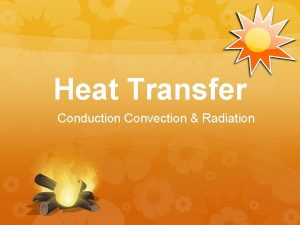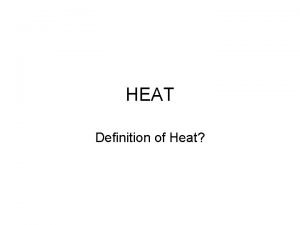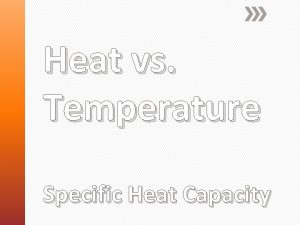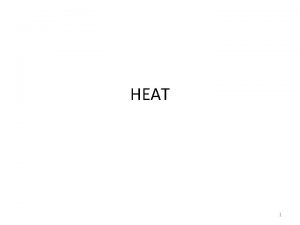What is Heat Has anyone ever put a


















- Slides: 18

What is Heat? Has anyone ever put a piece of ice down your shirt?

Heat – Hot or Cold _______ is what causes things to feel hot or cold It is what causes objects to get hot or cold Heat is always transferred to the object that has the ____ temperature Cold stethoscope to your back. The stethoscope is probably room temperature (20° C)but to your back(37° C) it feels cold

Heat and Thermal Energy Heat is transferred energy Thermal energy is the total kinetic energy of the particles that make up the substance. Thermal energy is measured in ______ – yes the same work Thermal energy depends partly on _____ and how _______ of a substance there is. The more particles, the more thermal energy.

Reaching the Same Temperature When you have two objects of different temperature, energy will be transferred until both objects have the _______ temperature.

Question Time Heat is always transferred to the object with a. the lower b. higher c. same temperature The amount of thermal energy an object has depends on a. how many particles there are b. temperature c. a and b d. none of the above When heat is transferred it always keeps transferring until both objects have the same temperature a. yes b. no

Ways Energy is Transferred Conduction – The transfer of energy from one substance to another by ____contact Conduction can also occur ______ a substance itself

Conductors or Insulators Conductors pass heat along very ______ Insulators pass heat along very ______ Metals are good conductors Styrofoam, wood are good insulators Insulators prevent heat from getting in or out _____

Fiberglass – a common insulator Egyptians used glass fibers in ancient days However, it wasn’t until 1932 when a burst of _____ hit a couple of glass blocks that a researcher was trying to weld together The burst of air blew the molten glass into very fine glass fibers

Convection The transfer of thermal energy by the movement of a ______ or a ______ Liquids move in a _______ pattern due to convection. These are often called cells and make up a convection current I. E. Wind patterns in the world

Radiation Transfer of energy by ______waves I. E. visible light and infrared waves These waves don’t need a medium Do you know the other electromagnetic wave types? UV, x-ray, radio, gamma, microwave

Question Time Conductors transfer heat by a. moving air b. direct contact c. through electromagnetic waves Insulators always prevent heat from getting in or out a. yes b. no. The transfer of heat by the movement of a liquid or gas is called a. conduction b. radiation c. convection. Radiation transfers heat by a. moving air, electromagnetic waves, c. direct contact

The Greenhouse Effect The earth’s atmosphere allows the sun’s visible light to pass through When the rays hit the earth they bounce off and become _____. These longer rays are trapped in our atmosphere because of the _______ found there. These gases include _______, and _____.

Thermal Conductivity The ______ at which an object conducts thermal energy For example metal conducts heat faster than cloth so it heats up faster

Specific Heat The amount of energy needed to raise 1 __of a substance by 1°C Every substance has a different specific heat Chart – p. 285 The _____ the specific heat of an object the longer it will take to heat up.

Heat, Temperature and Amount Energy transferred between objects can’t be measured directly It must be calculated _____ – the amount of energy that is transferred between two object that are at different temperatures Heat(J)=specific heat x mass x change in temperature

Question Time The greenhouse effect works on earth because when the sun’s rays come in and bounce off the earth they become a. shorter b. the same size c. longer All of the following are greenhouse gases except a. oxygen b. methane c. carbon dioxide d. water vapor The amount of energy transferred between to objects of different temperatures is known as a. calories b. heat c. thermal conductivity d. specific heat The exchange of heat between objects can be measured directly a. yes b. no Specific heat is the amount of energy required to raise one gram of a substance one degree Celsius.

Time to Summarize Heat energy is transferred between objects that are two different temperatures. Thermal energy is the total kinetic energy of the particles that make up the substance. Thermal energy will always be transferred from the higher to the lower temperature. Transfer of thermal energy ends when two objects are in contact at the same temperature. Conduction, convection, and radiation are three ways thermal energy is transferred.

Time to Summarize II Specific Heat is the amount of energy needed to change the temperature of 1 kg of a substance by 1°C. Energy transferred by heat cannot be measured directly. It must be calculated using specific heat, mass and the change in temperature. Every transferred by heat is expressed in joules (J) and is calculated as follows: Heat(J) = specific heat (J/kgx°C) x mass(kg) x change in temperature (°C)
 Of course anyone who has ever perused
Of course anyone who has ever perused Ever ancient ever new
Ever ancient ever new Ever ancient ever new
Ever ancient ever new Ever ancient ever new
Ever ancient ever new Ever tried ever failed no matter
Ever tried ever failed no matter Othello put out the light
Othello put out the light You put your left foot in you put your left foot out
You put your left foot in you put your left foot out No one has ever seen her
No one has ever seen her Verbna nedilia
Verbna nedilia Elements of spoken word poetry
Elements of spoken word poetry Repetition sound device
Repetition sound device Another jesus in the bible
Another jesus in the bible You owe nothing to anyone
You owe nothing to anyone Running with believers
Running with believers 1 timothy 1 10
1 timothy 1 10 Ms jones isn't as nice ms smith
Ms jones isn't as nice ms smith Something anything someone anyone somewhere anywhere
Something anything someone anyone somewhere anywhere Who does creon advise oedipus to send for?
Who does creon advise oedipus to send for? A dependent adult is anyone over the age of 65.
A dependent adult is anyone over the age of 65.



































